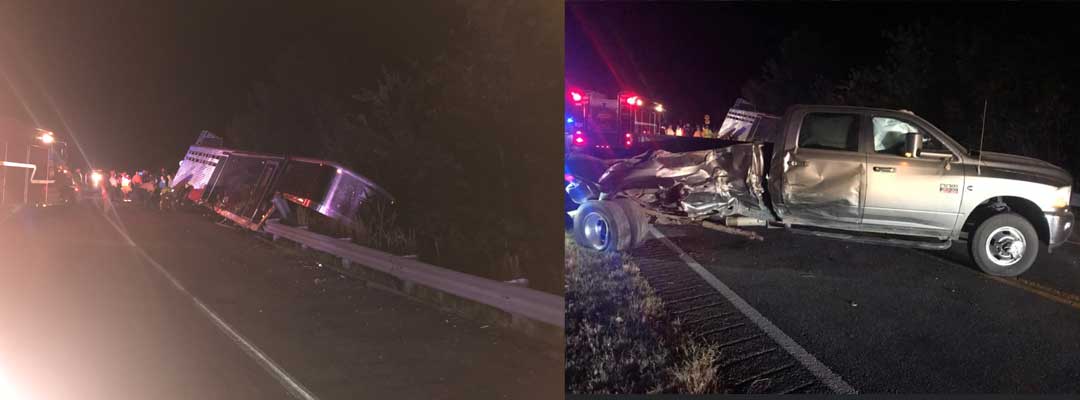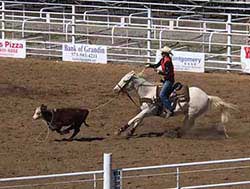
5 tips for safe horse hauling, including the invaluable importance of horse shipping boots
Kailey Schmidt was at the wheel of a truck pulling three horses home from a college rodeo. Two friends, also members of the University of Tennessee-Martin rodeo team, were with her in the cab. It was 11 o’clock at night when Kailey noticed a car was speeding toward an upcoming intersection. The driver didn’t see the stop sign he was soon to blow past. Kailey did and pulling a 42-foot trailer with horses, she knew there wasn’t time for them to stop. She stepped on the gas with hopes of making it across the intersection.
The oncoming car T-boned the bed of her truck, sending their truck spinning so fast that it slammed against the living quarter compartment of the horse trailer, detaching completely from the gooseneck hitch. The horse trailer’s emergency brake cable allowed it to come to a standstill; however, its resting place left the horse compartment dangling on top of guardrails over a 30-foot drop to a gully.
“If that car would have been a few seconds earlier, it would have killed all three girls -- and just a few seconds later, killed all three horses,” said John Luthi, head coach of the UTM rodeo team.
As the three women stepped from the truck, they were each unharmed but in shock. “I looked up to see our horse trailer on the edge of rolling off a gully,” recalled Kailey Schmidt. “When I picked up my phone to dial 911, I couldn’t believe the words coming out of my mouth.”
The horses and trailer were teetering on the guardrails, and it wasn’t safe to get on to help the horses. “It would be silent, and then the horses would start thrashing really bad. I could hear the horses struggling to get up. We were able to cut their lead ropes so they wouldn’t choke,” Schmidt said.
One of the horses on the trailer was Tater, who was gifted by Kailey’s parents for her 13th birthday.
Getting the Horses Out Safely

Half of the UTM rodeo team was miles behind them, and soon 10 horse trailers were parked on the side of the highway. They were there for emotional support and to lend a hand however they could. Sometime later, a wrecker arrived to remove the horse trailer from atop the guard rails to safety.
“One horse was trailered immediately to an emergency vet clinic. He was left with severe injuries and a long road to recovery,” recalled Schmidt.
“My horse was the only one who could pull himself up on his own. He was the only one wearing Back on Track wraps that night. The wraps played a huge part in enabling him to recover so fast. Admittedly, a lot of the time you’re just ready to hit the road but thankfully that night, I put on his Back on Track wraps before I left the rodeo. With the wraps, he was thankfully not cut up down his lower leg or severely injured. His legs were clean where the wraps were. To this day, he is the only horse on that trailer that is back riding or competing after the wreck. Just four short weeks after the wreck, he was back to competing at Southern Arkansas University, and we won third in the long round tying goats.”
5 Safety Tips For Hauling Your Horse
- To help prevent injury while transporting your horse, wrap your horse’s legs or secure horse shipping boots or therapy boots.
- Always pack an equine first aid kit, even if you’re only traveling a few miles down the road.
- Ensure your vehicle is rated for the tow capacity to pull your horses and trailer.
- Make sure you have the right size of trailer ball for a secure fit to avoid a trailer coming unhitched.
- Always double-check that your tires are fully aired without cracks, all doors and slants are secure, trailer lights work properly and the hitch is completely secure before transport. See our selection of trailering supplies.
Healing After an Accident

Kailey’s love for horses started as a young girl, and like many, she has never grown out of it. “I was born and raised in the horse world. When I was a toddler, I wouldn’t go to sleep unless they walked me down the barn hallway every night.”
She knows she is lucky to still have her 13th birthday present Tater with her today, and that they can continue their riding and love for rodeo together. “He was the first colt I ever broke, and I was pretty green myself. We have learned together.” A finance major, she has two more years with UTM competing in “Everything they let me,” she said, which includes: goat tying, breakaway roping, team roping and barrel racing.
When asked how she has overcome such a traumatic accident, Kailey paused. A few moments later she continued, “You have flashbacks, but you have to accept it and move on. You can’t live life in fear. Keep moving forward.”
She credits UTM rodeo team head coach John Luthi for his inspiration and her positive perspective. Luthi has been a well-respected name in the rodeo ranks since he was a contestant, as five-time Prairie Circuit qualifier in bareback riding and a three-time qualifier in bull riding. He won 15 all-around saddles during his 22-year career as a contestant. As a college rodeo coach for now 39 years, his passion for the sport, and mentoring his team, is unwavering.
“Our rodeo team is on the road a lot,” said Luthi. “You have to have faith that you’ll make it and that things will be fine. We do a lot of praying and that’s part of life. It’s like when you get out of bed in the morning, you step off, and you have faith there’s a floor beneath your feet. You have to have faith and trust that things are going to be fine.”
This article originally appeared on Valley Vet and is published here with permission. Valley Vet Supply was founded in 1985 by veterinarians for people just like you - people who want the very best for their four-legged friends and livestock.
All photos courtesy of Valley Vet.
There are more informative articles in our section on Tack & Farm.
































